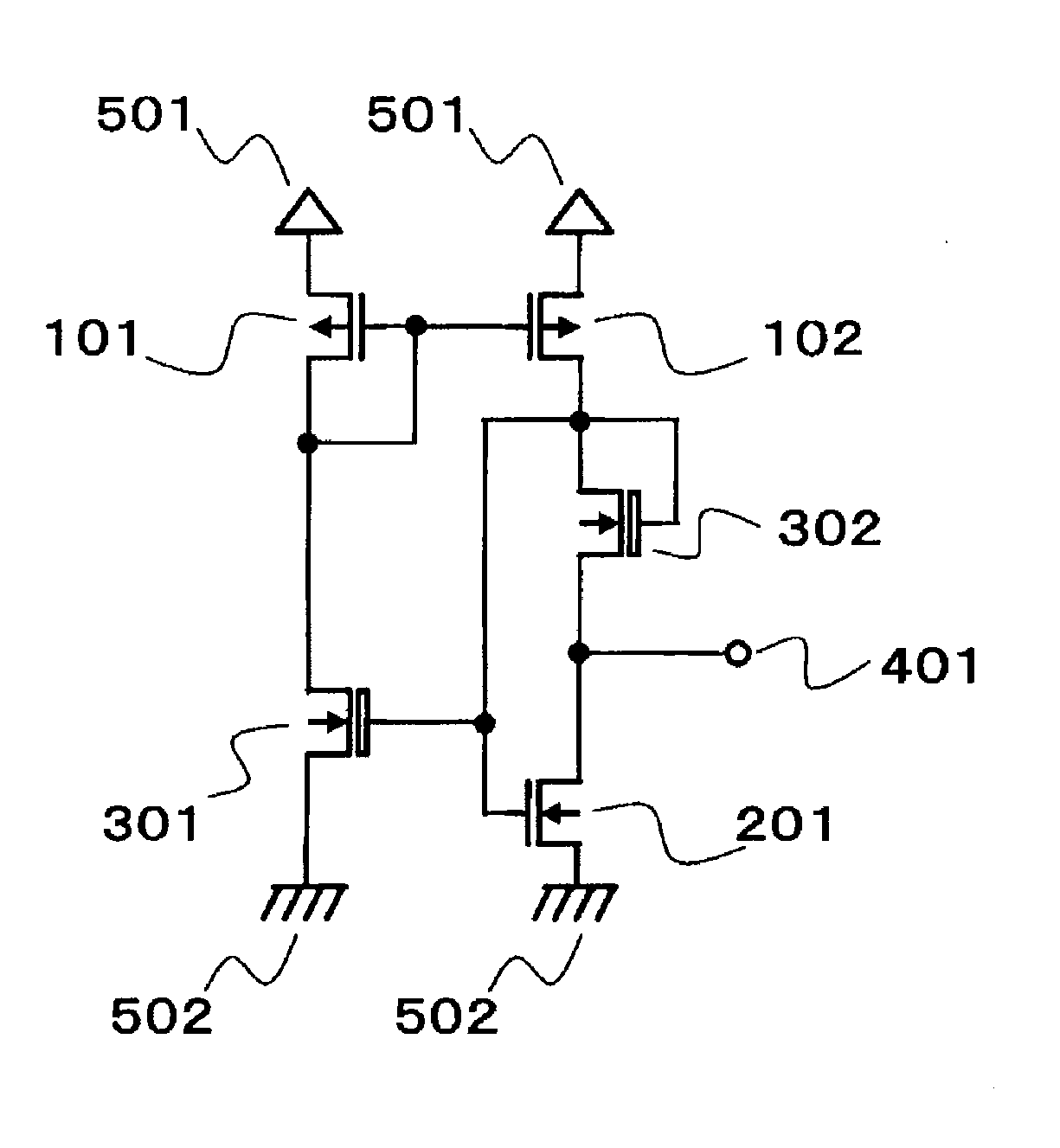Voltage reference circuit
a voltage reference circuit and voltage reference technology, applied in the direction of electric variable regulation, process and machine control, instruments, etc., can solve the problems of large influence on process variation and temperature characteristics, increase of variability factors due to process variation, disadvantageously increasing circuit scale, etc., to reduce variability in reference voltage level and increase circuit scale
- Summary
- Abstract
- Description
- Claims
- Application Information
AI Technical Summary
Benefits of technology
Problems solved by technology
Method used
Image
Examples
embodiment 1
[0024]FIG. 1 is a circuit diagram illustrating a voltage reference circuit according to the first embodiment.
[0025]The voltage reference circuit according to the first embodiment includes PMOS transistors 101 and 102 and NMOS transistors 201, 301, and 302, an output terminal 401, a power supply terminal 501, and an earth terminal 502. A threshold voltage (hereinafter referred to as Vtnl) of the NMOS transistors 301 and 302 is lower than a threshold voltage (hereinafter referred to as Vtnh) of the NMOS transistor 201. Respective K values of the NMOS transistors 201, 301, and 302 are K201 , K301, and K302. The PMOS transistor 101 and the PMOS transistor 102 constitute current mirror circuits.
[0026]Next will be explained connections in the voltage reference circuit according to the first embodiment.
[0027]Source terminals of the PMOS transistors 101 and 102 are connected to the power supply terminal 501. A gate terminal of the PMOS transistors 102 is connected to a gate terminal and a d...
embodiment 2
[0037]FIG. 3 is a circuit diagram illustrating a voltage reference circuit according to the second embodiment.
[0038]The voltage reference circuit according to the second embodiment includes PMOS transistors 101 to 106, NMOS transistors 201 to 204 and 301 to 303, an output terminal 401, a power supply terminal 501, an earth terminal 502, and resistors 601 to 602. A threshold voltage (hereinafter referred to as Vtnl) of the NMOS transistors 301 to 302 is lower than a threshold voltage (hereinafter referred to as Vtnh) of the NMOS transistors 201 to 202. Respective K values of the NMOS transistors 201, 202, 301, and 302 are K201, K202, K301, and K302. Respective resistance values of the resistors 601 and 602 are R601 and R602. The NMOS transistors 203 and 204 constitute a current mirror circuit. The PMOS transistor 101 and the PMOS transistors 102, 103, and 104 constitute current mirror circuits.
[0039]Next will be explained connections of the voltage reference circuit according to the ...
embodiment 3
[0052]FIG. 4 is a circuit diagram illustrating a voltage reference circuit according to the third embodiment.
[0053]The voltage reference circuit according to the third embodiment includes PMOS transistors 101, 701, and 702, NMOS transistors 201 and 202, an output terminal 401, a power supply terminal 501, and an earth terminal 502. An absolute value |Vtpl| of a threshold voltage (hereinafter referred to as Vtpl) of the PMOS transistors 701 and 702 is lower than an absolute value |Vtph| of a threshold voltage (hereinafter referred to as Vtph) of the PMOS transistor 101. Respective K values of the PMOS transistors 101, 701, and 702 are K101, K701, and K702. The NMOS transistors 201 and 202 constitute a current mirror circuit.
[0054]Next will be explained connections of the voltage reference circuit according to the third embodiment. Source terminals of the NMOS transistors 201 and 202 are connected to the earth terminal 502. A gate terminal of the NMOS transistor 202 is connected to a ...
PUM
 Login to View More
Login to View More Abstract
Description
Claims
Application Information
 Login to View More
Login to View More - R&D
- Intellectual Property
- Life Sciences
- Materials
- Tech Scout
- Unparalleled Data Quality
- Higher Quality Content
- 60% Fewer Hallucinations
Browse by: Latest US Patents, China's latest patents, Technical Efficacy Thesaurus, Application Domain, Technology Topic, Popular Technical Reports.
© 2025 PatSnap. All rights reserved.Legal|Privacy policy|Modern Slavery Act Transparency Statement|Sitemap|About US| Contact US: help@patsnap.com



